Reading the review, it seems to prove the point that there almost aren't any "high end" class D amps.
At least, that's why this one was a years in development, custom version of Hypex modified modules etc.
At least, that's why this one was a years in development, custom version of Hypex modified modules etc.
Some measurements from Archimago (I had to attach the images because the editor is unusable for me with inline images)
Attachments
-
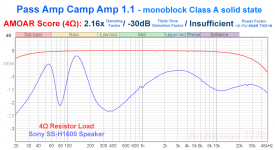 Pass ACA 4R - AMOAR Score.png65.9 KB · Views: 225
Pass ACA 4R - AMOAR Score.png65.9 KB · Views: 225 -
 Hypex NC252MP AMOAR Score.png54 KB · Views: 219
Hypex NC252MP AMOAR Score.png54 KB · Views: 219 -
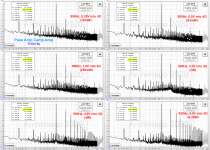 Pass Amp Camp Amp - THD+N, various power levels.png784.5 KB · Views: 217
Pass Amp Camp Amp - THD+N, various power levels.png784.5 KB · Views: 217 -
 Hypex NC252MP THD+N Panel.png646.6 KB · Views: 211
Hypex NC252MP THD+N Panel.png646.6 KB · Views: 211 -
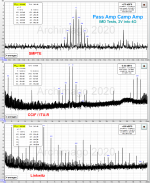 Pass ACA SMPTE, CCIF, Linkwitz IMD - 2V 4R.png233.3 KB · Views: 214
Pass ACA SMPTE, CCIF, Linkwitz IMD - 2V 4R.png233.3 KB · Views: 214 -
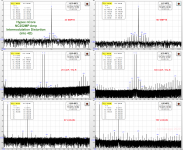 Hypex NC252MP IMD 2V and 10V.png611.5 KB · Views: 94
Hypex NC252MP IMD 2V and 10V.png611.5 KB · Views: 94 -
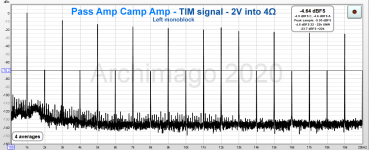 Pass ACA - TIM Signal 2V into 4R, Left.png73.4 KB · Views: 89
Pass ACA - TIM Signal 2V into 4R, Left.png73.4 KB · Views: 89 -
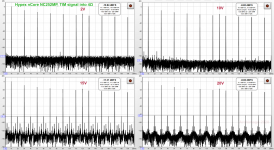 Hypex NC252MP TIM 2, 10, 15, 20V.png364 KB · Views: 86
Hypex NC252MP TIM 2, 10, 15, 20V.png364 KB · Views: 86
Reading the review, it seems to prove the point that there almost aren't any "high end" class D amps.
At least, that's why this one was a years in development, custom version of Hypex modified modules etc.
I think there was a Jeff Rowland amp that got rave reviews some years ago. Internally a pair of Ncore class D amps.
Model 825 & model 925.
Jan
Iirc the same thing happened with a Goldmund amp, inside there was a TO-5 (or 6 etc) power opamp, supposedly a custom version of a Burr Brown chip. They were frowned upon for doing it.
Later, "we" (the DIY community) all started building these LMxxxx opamps and I must say, some do sound really good.
The problem I had (maybe still do?) with Class D is the missing depth of the sound stage. Width is fine. Particularly bass seems less coloured. Been years I seriously listened to those though.
Later, "we" (the DIY community) all started building these LMxxxx opamps and I must say, some do sound really good.
The problem I had (maybe still do?) with Class D is the missing depth of the sound stage. Width is fine. Particularly bass seems less coloured. Been years I seriously listened to those though.
What is the problem with that? Academics do this constantly to push their barrow.......
And there are many of us academics who are wont to call others on that garbage, or at least flag such behavior. It's a huge problem and an impediment to progress. Yes, it's endemic to the system and inherent to being human, but it doesn't make it right.
It's almost like the pushes to reform publication and academia itself are a self-corrective action to ensure that the output (publications, etc) is a closer facsimile to the input (real results from research). Wonder what else looks like that 😉
Last edited:
Dear Jan,
I do not intend to argue with you about whether to use NFB or not.
But you know very well that I build ZGF (zero global feedback) amps with very low distortion.
So one does not need to use NFB to achieve low distortion, if it is the only goal.
But as you said here :
Global Feedback - A huge benefit for audio
if one wish to use NFB anyhow, then one should include the sound transducer.
The sound transducer distort a lot more than any modern amplifier.
So leaving that out of the feedback loop is poor engineering, to say the least.
And of course you also know how to do this : 🙂
Linear Audio | your tech audio resource
Linear Audio | your tech audio resource
Doing a control feedback loop with no phase shift at 20kHz would be a very nice engineering challenge.
Even those smart guys in veldhoven would say so. 😉
Cheers,
Patrick
I do not intend to argue with you about whether to use NFB or not.
But you know very well that I build ZGF (zero global feedback) amps with very low distortion.
So one does not need to use NFB to achieve low distortion, if it is the only goal.
But as you said here :
Global Feedback - A huge benefit for audio
if one wish to use NFB anyhow, then one should include the sound transducer.
The sound transducer distort a lot more than any modern amplifier.
So leaving that out of the feedback loop is poor engineering, to say the least.
And of course you also know how to do this : 🙂
Linear Audio | your tech audio resource
Linear Audio | your tech audio resource
Doing a control feedback loop with no phase shift at 20kHz would be a very nice engineering challenge.
Even those smart guys in veldhoven would say so. 😉
Cheers,
Patrick
Last edited:
The problem I had (maybe still do?) with Class D is the missing depth of the sound stage. Width is fine. Particularly bass seems less coloured. Been years I seriously listened to those though.
Oh boy. Ohhh boy.
You don't seem to realize that depth perception is a matter of L/R level and time differences, frequency response and reflections/reverb. All of this is baked into the recording and no amp can change that.
Regarding level differences you'd have to have a seriously underpowered and distorting/clipping amp, which would however also reduce stereo width which you say is not a problem.
Time differences? No, just no. Phase shift, should be pretty much the same for both channels, is largely inaudible anyway, is far worse in "audiophile" DACs and amps where people don't complain about depth, and so on..
Frequency response: are you possibly missing the resonant boosted peaks that you get with higher output impedance? I suggest an EQ to fix that.
I tend to agree with Hugh. I say there is a difficulty with equating sound quality and THD. If there were no other parameters at play then this would be sensible.
Just to be controversial, I think Bruno is somewhat full of it. It’s not like he invented the Bessel filter. He is using really old technology to push up his in-band THD figure. That’s been an option for over a century, although not digitally implementable. What could be better for THD marketing? Class D is a power for price/cost solution. It’s not an audiophile solution. The fidelity problems of class D go way beyond THD and this illustrates how superficial THD is as a measure.
Hi Brian
I have to dissagree with you.
Stein
one does not need to use NFB to achieve low distortion, if it is the only goal.
Yes agreed. Arto Kolinummi did a great job writing about it.
if one wish to use NFB anyhow, then one should include the sound transducer.
Cheers,
Patrick
I don't see that connection. Using feedback to improve your amplifier is a valid tactic on itself. I think we were discussing amplifiers with or without global feedback. If you want to include the transducer in the global loop, the comparison is skewed because obviously you can't include the transducer in a non-global-feedback scheme.
Jan
Last edited:
All of this is baked into the recording and no amp can change that.
Apparently negative phase second HD can increase a sense of depth
Oh boy. Ohhh boy.
You don't seem to realize that depth perception is a matter of L/R level and time differences, frequency response and reflections/reverb. All of this is baked into the recording and no amp can change that.
Regarding level differences you'd have to have a seriously underpowered and distorting/clipping amp, which would however also reduce stereo width which you say is not a problem.
Time differences? No, just no. Phase shift, should be pretty much the same for both channels, is largely inaudible anyway, is far worse in "audiophile" DACs and amps where people don't complain about depth, and so on..
Frequency response: are you possibly missing the resonant boosted peaks that you get with higher output impedance? I suggest an EQ to fix that.
You're basically saying that ucd, T+A amd and a van Medevoort made great recordings sound bad, and you're saying amps can't chance that and you're saying I listened at higher levels than 50 watts on a 18" horn based speaker at 3 meters distance and...
It's all over the place. I can't even start answering this one.
Dear Jan,
I build ZGF (zero global feedback) amps with very low distortion.
Cheers,
Patrick
Care to share?
I guess not.😉
Stein
If you want to include the transducer in the global loop, the comparison is skewed because obviously you can't include the transducer in a non-global-feedback scheme.
Jan
What I meant to say is that if you use NFB, then you should go all the way and include the transducer.
Then you can really claim low distortion of the entire chain.
Otherwise the transducer dominates.
Which is of course why Rob does it.
Patrick
Yes agreed. Rob pioneered digital motional feedback. But as far as I know it is only used on the (sub)woofer.
Philips at the time used it up to 500Hz IIRC.
Jan
Philips at the time used it up to 500Hz IIRC.
Jan
But Patrick, you also design discrete opamps for fun 🙂
They are not used in any of my own audio gear. 🙂
They are just a challenge.
Patrick
No.You're basically saying that ucd, T+A amd and a van Medevoort made great recordings sound bad,
No.and you're saying amps can't chance that
No.and you're saying I listened at higher levels than 50 watts on a 18" horn based speaker at 3 meters distance and...
Indeed it is. Your attempt at a response that is.It's all over the place. I can't even start answering this one.
Care to share?
Stein
The Pioneer Super Linear Circuit
https://www.diyaudio.com/forums/the...ls-blowtorch-preamplifier-ii-post5270193.html
The DAO SE all-FET Class-A ZGF Headphone Amplifier
XCEN Balanced to Single-Ended Converter Revisited
There is another balanced DAO being build which has even lower distortion.
We'll published in due course.
Patrick
With all due respect, I thought that this thread was about power amps, so please put up a circuit that is relevant instead of hijacking the thread with your marketing.😕
Stein
Stein
- Home
- Amplifiers
- Solid State
- Global Feedback - A huge benefit for audio